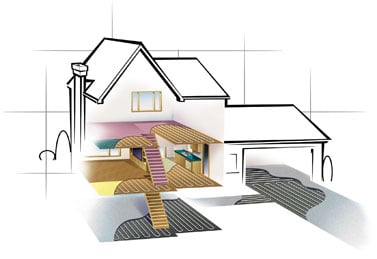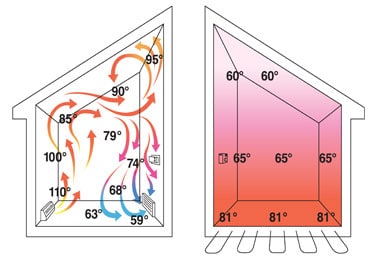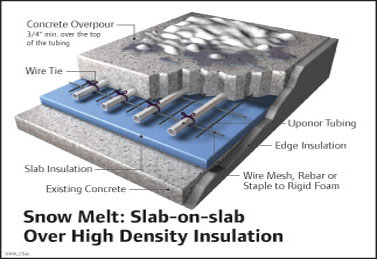Uponor Radiant Floor Heating

Advantages of Radiant Floor Heating
- Clean – Because radiant doesn’t use blowers, it doesn’t circulate dirt, dust, pollutants or allergens throughout the home.
- Comfortable – Reaches every corner of the house. Even takes the chill out of kitchen, bathroom and lower level floors.
- Economical – Could reduce your heating bill dramatically. Saving energy is good for the environment.
- Guaranteed – When installed by a trained professional the Uponor Radiant Heating System is guaranteed for 30 years.
- Practical – Uponor radiant floor heating concentrates the heat near the floor where you benefit from it.
- Versatile – Works with any kind of floor covering. Ideal for installations in concrete slabs: lower levels, basements and garages.

How Does it Work?

In a radiant floor heating system, warm water flows through tubes located underneath the floors. That warmth radiates up from the floors and warms everything it comes in contact with – including people.
Radiant systems are compatible under any type of floor covering – carpet, wood, slate, tile, linoleum, and even concrete.
The water in a radiant system has a capacity to transport energy 3,500 times greater than air, so it can heat (and even cool) using less energy than a forced-air system. This amounts to greater comfort at a lower thermostat setting, which provides lower energy bills. In fact, more people are comfortable with radiant floor heating at a lower thermostat setting than with forced-air heating at a higher thermostat setting.
A radiant heating system works in zones, allowing different areas of a home to heat at different temperatures. This allows typically chilly rooms, such as bathrooms, basements and entryways, to receive more heat when needed. At the same time, rooms with less traffic, such as a den or formal dining room, can be set to a lower thermostat setting, making the system even more energy-efficient.
Forced Air vs. Radiant

With a forced air system, all the heat ends up at the ceiling. Lower parts of the room will be warm near the registers, or cold near the returns. A radiant system keeps heat at the bottom of the room (where the people are).
Radiant Cooling
Radiant cooling has gained recent popularity in Europe because it offers the potential to reduce cooling energy consumption and peak cooling loads. The system not only offers comfort with great energy efficiency, it also allows for downsizing or eliminating individual air conditioning units.
Much like a radiant heating system, the radiant cooling system maintains comfortable temperatures by circulating a water-and-glycol solution through crosslinked polyethylene tubing that is installed under the floor.
In a radiant heating application, the energy moves away from the heated surface toward the cooler area to warm objects and people in an area. A radiant cooling system is simply the opposite. The energy moves toward the cooled surface from the warmer area, surrounding people with a cooler, comfortable temperature.
A radiant cooling system provides several options for offering ultimate comfort while also providing energy efficiency. For example, one radiant system can both heat and cool, and in some climates in North America, the system may do both throughout the day. Some designs can even transport heat from one side of the building to the other. And because radiant surfaces are often cooled only a few degrees below the desired indoor air temperature, there are many opportunities for innovative cooling sources such as night fluid cooling, ground-coupled hydronic loops and indirect evaporative cooling.
Snow & Ice Melting
Traditional methods of snow removal, such as shoveling and salting are costly, messy, and labour-intensive. But Uponor offers a superior alternative with the Uponor snow-melting system. In the Uponor snow-melting system warm water circulates through durable crosslinked polyethylene (PEX) tubing embedded in concrete, turf, asphalt, or sandbed. The warmth from the water warms the surface to a temperature that melts snow and ice on contact.
Snow and Ice Melt systems help lower maintenance costs and reduce the liability associated with slippery walk-ways. Damage to concrete and asphalt is reduced or eliminated. Damage to building entrances is also eliminated since no water, salt or ice melt chemicals are tracked in.

Why Uponor?
A true pioneer in the field, Uponor first unveiled crosslinked polyethylene tubing for potable water systems in the late 1960s. Thus, before others had entered the market, Uponor had thousands of feet of PEX-a working trouble-free in real-world installations. With 12 billion feet of Uponor PEX-a now installed worldwide, it has become the trusted solution for plumbing and heating systems for residential and commercial buildings, and multi-purpose plumbing and fire sprinkler systems for one- and two-family homes. Designed, installed and operated properly, Uponor PEX-a systems will last as long as the structures they inhabit.


